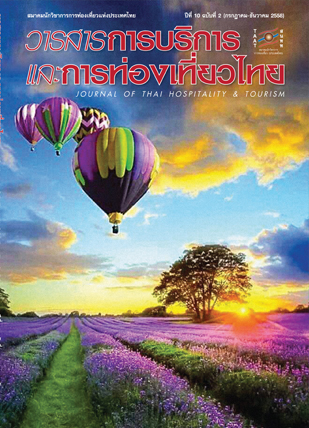แนวทางการพัฒนากิจกรรมการท่องเที่ยวและแหล่งท่องเที่ยวให้เกิดความยั่งยืนของตลาดนํ้าอัมพวา จังหวัดสมุทรสงคราม
Main Article Content
บทคัดย่อ
การวิจัยเรื่อง แนวทางการพัฒนากิจกรรมการท่องเที่ยวและแหล่งท่องเที่ยวให้เกิดความยั่งยืนของตลาดน้ำอัมพวา จังหวัดสมุทรสงครามมีวัตถุประสงค์เพื่อ (1) ศึกษาลักษณะส่วนบุคคลที่มีผลต่อความพึงพอใจต่อการท่องเที่ยวตลาดน้ำอัมพวา จังหวัดสมุทรสงครามของนักท่องเที่ยวชาวไทย (2) ศึกษาศึกษาลักษณะทางกายภาพ แหล่งท่องเที่ยว และกิจกรรมการท่องเที่ยวอย่างยั่งยืนของตลาดน้ำอัมพวาที่มีผลต่อความพึงพอใจต่อการท่องเที่ยวตลาดน้ำอัมพวาจังหวัดสมุทรสงคราม ของนักท่องเที่ยวชาวไทย (3) ศึกษาความสัมพันธ์ระหว่างความพึงพอใจต่อการท่องเที่ยวกับพฤติกรรมการท่องเที่ยวตลาดน้ำอัมพวา จังหวัดสมุทรสงคราม ของนักท่องเที่ยวชาวไทย (4)ศึกษาพฤติกรรมการท่องเที่ยวและพฤติกรรมที่ใช้หลักความยั่งยืนในการท่องเที่ยวที่มีผลต่อแนวโน้มการท่องเที่ยวซ้ำในอนาคตที่ตลาดน้ำอัมพวา จังหวัดสมุทรสงคราม ของนักท่องเที่ยวชาวไทย (5) ศึกษาแนวทางการพัฒนากิจกรรมการท่องเที่ยวและแหล่งท่องเที่ยวให้เกิดความยั่งยืนของตลาดน้ำอัมพวา จังหวัดสมุทรสงครามการศึกษาครั้งนี้ใช้วิธีการศึกษาวิจัยเชิงปริมาณ และเชิงคุณภาพ โดยมีกลุ่มคนที่ศึกษา คือ กลุ่มเจ้าหน้าที่ในอำเภออัมพวา ผู้ประกอบการในตลาดน้ำอัมพวา กลุ่มตัวแทนชุมชน และกลุ่มนักท่องเที่ยวชาวไทย
ผลการวิจัยเชิงปริมาณพบว่า นักท่องเที่ยวส่วนใหญ่เป็นเพศหญิง อายุ 26-35 ปี สถานภาพโสด ระดับการศึกษาขั้นปริญญาตรี รายได้ต่อเดือน 10,001-20,000 บาท และกรุงเทพมหานคร มีความคิดเห็นต่อลักษณะทางกายภาพโดยรวมของตลาดน้ำอัมพวา จังหวัดสมุทรสงคราม โดยรวมในระดับดี มีความคิดเห็นต่อแหล่งท่องเที่ยวในตลาดน้ำอัมพวา จังหวัดสมุทรสงครามโดยรวม ในเรื่องของร้านอาหารริมคลอง ร้านขายของที่ระลึก และวัด,โบสถ์คริสต์โบราณสถาน อยู่ในระดับดี มีความต้องการในเรื่องกิจกรรมการท่องเที่ยวอย่างยั่งยืนในตลาดน้ำอัมพวา จังหวัดสมุทรสงครามโดยรวมในระดับต้องการ มีความพึงพอใจต่อการท่องเที่ยวตลาดน้ำอัมพวา จังหวัดสมุทรสงคราม โดยรวมในระดับพอใจ พฤติกรรมนักท่องเที่ยวส่วนใหญ่มากับครอบครัว มาโดยรถส่วนตัว ค่าใช้จ่ายในการท่องเที่ยวโดยเฉลี่ยต่อครั้งต่ำกว่า 2,000 บาท เวลาที่ใช้ในการท่องเที่ยวโดยเฉลี่ย(ชม./ครั้ง)ต่ำสุด 1 ชม./ครั้ง สูงสุด 10 ชม./ครั้ง มูลค่าในการซื้อสินค้าในแต่ละครั้งโดยเฉลี่ย(บาท)ต่ำสุด 100 บาท สูงสุด 4,500 บาท จำนวนครั้งในมาเที่ยวตลาดน้ำอัมพวาในรอบ 1 ปี (ครั้ง) ต่ำสุด 1 ครั้ง/ปี สูงสุด 13 ครั้ง/ปี แนวโน้มการท่องเที่ยวซ้ำตลาดน้ำอัมพวาในอนาคตโดยรวม อยู่ในระดับดีอย่างมากแนวโน้มการท่องเที่ยวซ้ำในอนาคตในเรื่องโอกาสที่จะกลับมาเที่ยวตลาดน้ำอัมพวาในอนาคตภายใน 1 ปี (ครั้ง) ต่ำสุด 0 ครั้ง สูงสุด 15 ครั้ง นักท่องเที่ยวมีความคิดเห็นต่อพฤติกรรมที่ใช้หลักความยั่งยืนในการท่องเที่ยวในตลาดน้ำอัมพวา จังหวัดสมุทรสงครามโดยรวมอยู่ในระดับดี
สำหรับผลการวิจัยเชิงคุณภาพพบว่า ทางเทศบาลตำบลอัมพวาได้กำหนดนโยบายแบบแผนเพื่อการพัฒนาไว้เรียบร้อย โดยดำเนินการไปอย่างช้าๆพัฒนาแบบทีละขั้นและต่อเนื่องเพื่อการบริหารและการจัดการนั้นง่ายขึ้นและสามารถควบคุมได้เพราะที่ผ่านมานั้น ตลาดน้ำอัมพวาเติบโตเร็วเกินจนไร้ทิศทาง และไม่มีมาตรการที่สามารถจะควบคุมได้อย่างมีประสิทธิภาพ ส่วนข้อเสนอะแนะเนื่องจากเทศบาลอัมพวาเป็นเทศบาลขนาดเล็ก จึงส่งผลให้ได้รับงบประมาณที่จะนำมาพัฒนาจำนวนไม่มาก เพราะรายได้ส่วนมากมาจากนักท่องเที่ยว ในส่วนของชุมชนตลาดน้ำอัมพวานั้น จะมีนโยบายให้มีการรวมกลุ่มกันโดยการให้ชมรมแม่ค้าแผงลอย ประธานชุมชน ชุมชนคนรักอัมพวา มาปรึกษารับฟังปัญหาของแต่ละฝ่ายในแต่ละด้าน เพื่อแก้ไขปัญหาและเพื่อให้เกิดการพัฒนาตลาดน้ำให้ยั่งยืนต่อไป ส่วนนโยบายเรื่องตลาดน้ำของเทศบาล ในอนาคตอาจจะขยายทางเดินริมคลองให้กว้างขึ้นโดยให้เกิดผลกระทบต่อผู้ประกอบการน้อยที่สุด และมีแผนการพัฒนา ให้มีตลาดน้ำทุกวันไม่ใช่เฉพาะวันศุกร์ เสาร์ อาทิตย์ เพียงอย่างเดียว แต่อาจจะต้องพัฒนาไปอย่างเป็นระบบ มีการควบคุมราคาสินค้าและคุณภาพให้เหมาะสม เพื่อเป็นการพัฒนาให้ตลาดน้ำอัมพวาดีขึ้นและอยู่อย่างยั่งยืนต่อไป
Article Details
เอกสารอ้างอิง
[2] กัลยา วานิชย์บัญชา. (2545). การวิเคราะห์สถิติ: สถิติสำหรับการบริหารและการวิจัย. (พิมพ์ครั้งที่ 6). บริษัทธรรมสาร.
[3] กาญจนา กันภัย และคณะ. (2552). พฤติกรรมนักท่องเที่ยว กรณีศึกษาตลาดน้ำอัมพวา. ปริญญาบริหารธุรกิจบัณฑิต คณะวิทยาการจัดการ มหาวิทยาลัยราชภัฏจันทรเกษม.
[4] ธัญญารัตน์ บุญต่อ. (2552). รายงานการวิจัยเรื่องปัจจัยที่มีอิทธิพลต่อความพึงพอใจของผู้ใช้บริการโรงแรมเวสติน แกรนด์ สุขุมวิท. ภาคนิพนธ์บริหารธุรกิจมหาบัณฑิต คณะบริหารธุรกิจ มหาวิทยาลัยศรีนครินทรวิโรฒ.
[5] นพดล ภาคพรต. (2548). ความรู้เบื้องต้นเกี่ยวกับการท่องเที่ยวในเอกสารชุดฝึกอบรมทางไกล หลักสูตรการวัดการการท่องเที่ยวชุมชนอย่างยั่งยืน (หน่วยที่ 2). นนทบุรี: มหาวิทยาลัยสุโขทัยธรรมาธิราช.
[6] นิคม จารุมณี. (2536). การท่องเที่ยวและการจัดการอุตสาหกรรมการท่องเที่ยว. กรุงเทพฯ: โรงพิมพ์โอ.เอส.พริ้นติ้งเฮ้าส์.
[7] บุญเลิศ จิตตั้งวัฒนา. (2542). การวางแผนพัฒนาการท่องเที่ยวแบบยั่งยืน. (พิมพ์ครั้งที่ 1). คณะมนุษยศาสตร์ มหาวิทยาลัยเชียงใหม่.
[8] วราภรณ์ จิวชัยศักดิ์. (2553). วิวัฒนาการของตลาดน้ำ. วันที่ค้นข้อมูล 17 พฤษภาคม 2557, จาก https://guru.google.co.th/guru/threads?tid=5d5f54daf2a1a417
[9] วิรุฬ พรรณเทวี. (2542). ความพึงพอใจของประชาชนต่อการให้บริการของหน่วยงานกระทรวงมหาดไทยในอำเภอเมือง จังหวัดแม่ฮ่องสอน. วิทยานิพนธ์ปริญญาวิทยาศาสตรมหาบัณฑิต สาขาวิชาส่งเสริมการเกษตร คณะเกษตรศาสตร์ มหาวิทยาลัยเชียงใหม่.
[10] อุดม เชยกีวงศ์. (2552). ตลาดน้ำ: วิถีชีวิตของชุมชนที่อาศัยอยู่ริมแม่น้ำ. กรุงเทพฯ: ภูมิปัญญาสร้างสรรค์.


